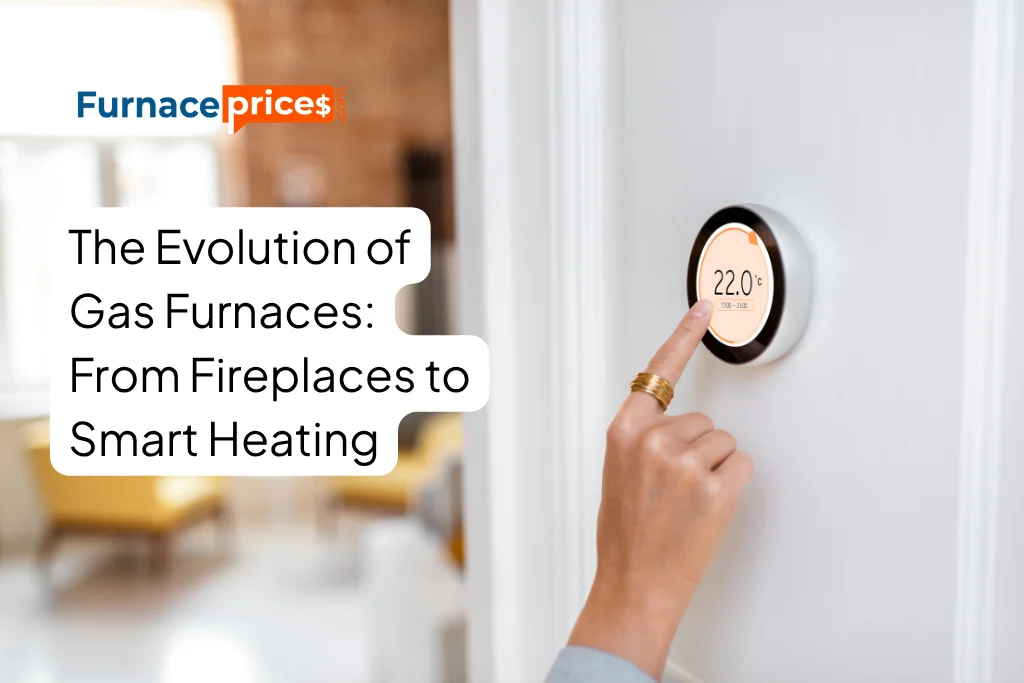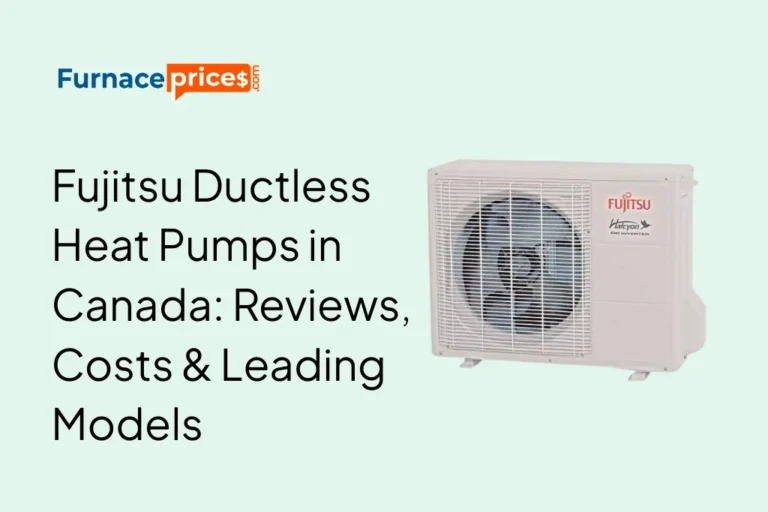The Evolution of Gas Furnaces: From Fireplaces to Smart Heating

Introduction
Today’s gas furnaces are incredibly quiet, highly convenient, and demand very little maintenance—a testament to the Evolution of Gas Furnaces and how far this technology has come.
However, achieving this level of comfort took years of innovation, investment, and creativity. Heating our homes wasn’t always this safe, efficient, or straightforward.
Gaining insight into your furnace can help you maintain it better, so let’s explore how gas furnaces evolved over time, how the technology progressed, and what heating looked like before these modern systems began keeping families warm through cold winters.
Before Gas Furnaces Came the Simple Fireplace
Early humans had only one reliable method to stay warm: fire. For centuries—up until the 1800s—people relied on wood and charcoal fires to heat their living spaces.
But in ancient homes, poor ventilation often meant rooms filled with smoke and soot. Open fires also lacked the ability to effectively warm large areas, forcing people to remain close to the flames for comfort.
As homes grew larger than just one-room dwellings, these early brick and stone fireplaces became more impractical and less efficient.
One of the earliest heating systems to warm larger areas was the kang—a clay or brick masonry stove from China that dates back over 7,000 years.
From Open Fires to Early Central Heating Systems
One of the first known central heating systems was the ondol, an underfloor heating method from Korea used at least 7,000 years ago. It worked by directing fire under thick floors made of stone or masonry to warm big areas.
Another historic example was the Roman hypocaust, also a wood-fired underfloor system, developed more than 2,100 years ago.
After the Roman Empire collapsed, the hypocaust system vanished, and central heating wasn’t revisited for more than a thousand years.
In medieval times, people went back to basic hearths with open roofs for ventilation. With the invention of the domestic chimney in the 12th century, fireplaces became more widespread.
Later, in both Europe and Asia, designs evolved into tiled cockle stoves—masonry stoves that were more efficient and featured better flue systems, helping to limit smoke and reduce cold drafts.
The Rise of Modern Central Heating
In the 1700s, central heating began gaining serious attention. Common methods of the time involved hot air, hot steam, hot water, or electricity to warm homes.
In the category of hot air, a major milestone came with Benjamin Franklin’s creation of the Franklin Stove in 1741. This metal-lined unit featured a hollow baffle and generated more heat with less smoke. Its duct system helped distribute warm air more evenly throughout the room.
In steam heating, James Watt—known for the Watt steam engine—built a home system by connecting pipes to a boiler and channeling steam throughout his house.
At the same time, Franz San Galli invented the first hot water radiator in 1855, laying the groundwork for the radiators we still use today.
Soon after, in the early 1880s, Thomas Edison introduced the electric heater, expanding the options for home heating.
Then in 1885, Dave Lennox transformed the heating market with a cast iron coal-powered radiator. It didn’t require wood fuel, was relatively low-cost, and became a popular choice for homeowners. This unit also used natural convection to circulate warm air more effectively—much like the Franklin Stove had done earlier.
Alice Parker’s Furnace and The Evolution of Gas Furnaces
We owe our warm, cozy winters largely to an innovative woman named Alice Parker, who was the first to patent a central heating system in the United States in 1919.
Her design—now over a century old—laid the foundation for the home heating systems we use today. It featured a thermostat-controlled unit that pulled in cool air, passed it through a natural gas-fueled heat exchanger, and distributed the heated air throughout the house using ductwork and natural convection.
This invention marked a significant milestone in heating technology. Not only was it highly effective, but it also shifted home heating from wood and coal to natural gas, a cleaner and more efficient energy source. Later on, electric fans were introduced to enhance air circulation and improve overall performance.
Shortly after Parker’s patent, gas and oil-powered forced-air furnaces began to replace coal-burning systems. This transition freed homeowners from the labor-intensive job of stoking fires with coal or wood.
Alice Parker’s design proved so functional that it continues to serve as the core concept of modern central heating systems. While advances in technology have improved efficiency, performance, and comfort, the basic design—thermostat control, gas heating, and ducted air distribution—remains largely unchanged.
It’s also important to recognize that Parker’s invention was revolutionary for its time not just technically, but also socially. At a time when few women—especially African American women—were recognized in engineering or science, Parker’s patent was a powerful statement of innovation and intellect. Her work paved the way for more inclusive participation in STEM fields, and she continues to be cited as a pioneer in both energy efficiency and gender equity in technology.
Modern Improvements That Have Transformed Gas Furnaces
Even though Parker’s concept has endured the test of time, the gas furnace has undergone significant refinements over the past several decades. These changes have made furnaces more energy-efficient, user-friendly, and environmentally responsible.
Here are some key innovations that have made modern gas furnaces better than ever:
Secondary Heat Exchangers for Higher Efficiency
In Parker’s original design, a single heat exchanger warmed the air while keeping dangerous combustion gases safely separated.
Today’s high-efficiency models—known as condensing furnaces—go a step further. They include a secondary heat exchanger that extracts additional heat from exhaust gases before they exit the system.
This extra step reduces energy waste, cuts down on heating costs, and boosts annual fuel utilization efficiency (AFUE) ratings. Condensing furnaces are now among the most efficient heating systems available for residential use.
Two-Stage and Modulating Gas Valves
Traditional furnaces operate with a single-stage gas valve, meaning the system is either fully on or completely off. It runs at 100% capacity until the thermostat setting is reached, then shuts off—causing noticeable temperature swings and greater energy use.
To improve this, manufacturers introduced two-stage furnaces, which allow the unit to operate at two different power levels, usually around 60% and 100%. This allows the furnace to use less fuel in milder conditions, resulting in quieter operation and lower energy bills.
Taking it further, modulating furnaces were developed. These systems can adjust their output in small, precise increments, allowing them to run continuously at a low level and maintain a stable indoor temperature with minimal energy use.
This level of control is particularly useful in regions with variable weather, where subtle shifts in output help homes maintain comfort without excessive wear on the system.
Electronic Ignition for Better Performance
Older gas furnaces used a standing pilot light—a small flame that burned continuously—to ignite the burners. This method was inefficient, wasting gas and requiring frequent relighting.
Modern systems now rely on electronic ignition, which activates the burners only when needed. This innovation saves fuel, reduces energy costs, and eliminates maintenance issues related to pilot lights.
Electronic ignition systems are now standard in nearly all new furnaces, increasing both safety and efficiency.
Smart and Programmable Thermostats
Thermostats have come a long way. While basic thermostat concepts existed as far back as 1620, major progress came in 1886, when Albert Butz patented the first electric thermostat. It controlled a damper system based on room temperature, laying the groundwork for the modern thermostat.
Butz went on to found a company that would eventually become Honeywell, a major player in HVAC technology.
Over time, thermostats became programmable, allowing users to set schedules for temperature changes throughout the day. A major leap forward came in 2007, when Ecobee launched the first smart thermostat.
Smart thermostats are now popular for their energy-saving capabilities. These devices learn user habits, automatically adjust temperatures based on occupancy, and can be controlled remotely via smartphone apps. They make managing home comfort easier and more efficient than ever.
As technology continues to advance, smart thermostats are also integrating with home automation systems like Google Nest, Amazon Alexa, and Apple HomeKit, giving homeowners even more control over their environment.
ENERGY STAR® Certified Gas Furnaces
One of the most important advancements in furnace technology is the widespread availability of ENERGY STAR® certified models, which help homeowners identify systems with top-tier efficiency.
Established in 1992 by the U.S. Department of Energy and the Environmental Protection Agency (EPA), the ENERGY STAR program labels appliances that meet strict energy efficiency guidelines.
To qualify for the ENERGY STAR label, a gas furnace must have an AFUE rating of 95% or higher, meaning it converts 95% of fuel into usable heat while wasting just 5%. Some of the most advanced models even boast AFUE ratings of 99%—almost complete fuel efficiency.
This has made it easier than ever for homeowners to choose cost-effective, eco-friendly heating systems that reduce both carbon footprints and utility bills.
ENERGY STAR-rated furnaces are especially attractive for eco-conscious consumers, and some government programs even offer rebates or tax credits for installing high-efficiency equipment. This has encouraged wider adoption of advanced heating systems in both residential and commercial buildings.
Making the Most of Your Furnace Investment
Thanks to these innovations, upgrading your heating system today means you have access to affordable, efficient, and dependable options across all price points.
Whether you’re in the market for a basic single-stage furnace or a top-of-the-line modulating unit with smart thermostat compatibility, there’s a system available to meet your needs.
To ensure your furnace delivers optimal performance, be sure to:
- Choose the correct furnace size for your home’s layout and insulation
- Hire a licensed HVAC technician for professional installation
- Schedule regular maintenance and inspections to keep your system running efficiently
These steps are critical to extending your furnace’s lifespan and maximizing comfort and efficiency in your home. Even the most advanced furnace will underperform if it’s incorrectly sized, poorly installed, or improperly maintained.
As we look ahead, innovations in sustainability, automation, and renewable energy integration may continue to shape the future of home heating. But the foundation laid by Alice Parker will likely remain central to how we heat our homes—quietly, efficiently, and reliably.
Final Thoughts
Gas furnaces have come a long way—from simple fire-based heating to today’s efficient, smart systems. Thanks to innovators like Alice Parker and decades of technological progress, we now enjoy reliable, safe, and energy-efficient home heating.
Understanding this evolution helps us make smarter choices when upgrading or maintaining our systems. While new advancements continue to shape the future, the core principles of gas furnace design remain as relevant as ever.
For more information on energy efficiency standards and incentives in Canada, visit Natural Resources Canada.
📞 Have questions? Contact us or email us at contact@furnaceprices.com.
✅ Start comparing today and make the right choice with confidence!







